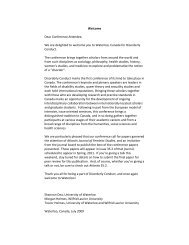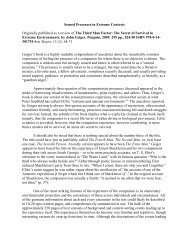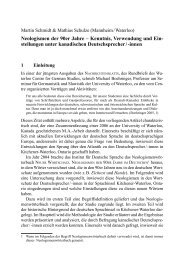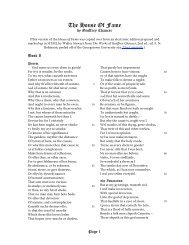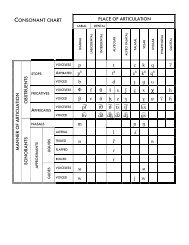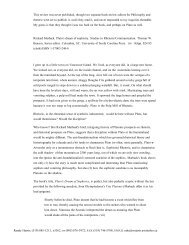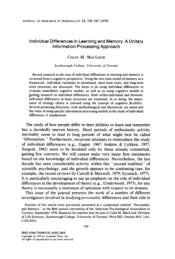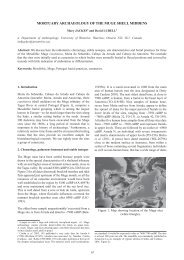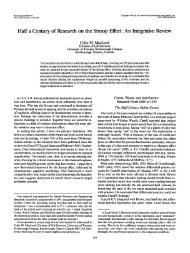The mid seventeenth century collapse of Iroquoian Ontario:
The mid seventeenth century collapse of Iroquoian Ontario:
The mid seventeenth century collapse of Iroquoian Ontario:
You also want an ePaper? Increase the reach of your titles
YUMPU automatically turns print PDFs into web optimized ePapers that Google loves.
the Mid Seventeenth centuRy collapSe <strong>of</strong> iRoquoian on ta R i o<br />
MCM J:A N Estimation from MCM Estimation from J:A<br />
0.132 0.347 373 Total excavated 12.21 11.26<br />
0.138 0.286 27 Bead Phase II 13.03 9.24<br />
0.208 0.706 118 Bead Phase IIIa 24.78 26.31<br />
0.105 0.233 163 Bead Phase IIIb 8.94 7.60<br />
0.145 0.390 281 Bead Phases IIIa +IIIb 14.01 12.78<br />
0.087 0.164 103 Feature 62 7.1 5.6<br />
Fig. 5. Grimsby cemetery total fertility rate estimates derived from the mean childhood mortality (MCM) and<br />
juvenile adult ratio (J:A) values.<br />
<strong>The</strong> causes <strong>of</strong> Grimsby palaeodemographic discrepancies<br />
An epidemic struck <strong>Ontario</strong> in 1634 (Jackes, 1983, 1988). <strong>The</strong> disease may have derived<br />
from a smallpox epidemic that began in London in 1628. Recorded epidemics from 1630-34<br />
were all perhaps the same smallpox epidemic initially spread by English settlers arriving in<br />
Massachusetts in 1630, and by Dutch traders, to the Abenaki and Mohawk. It might have<br />
been spread further by warfare when, in April 1634, 1 500 Seneca warriors entered <strong>Ontario</strong><br />
(fig. 2).<br />
<strong>The</strong> nature <strong>of</strong> the 1634 epidemic<br />
<strong>The</strong> 1634 epidemic in New France is described (JR, 8, p. 87, 89) as first affecting the<br />
Montagnais at Trois Rivières with high morbidity and some mortality. It infected the aboriginal<br />
members <strong>of</strong> the yearly trading expedition and, introduced to Huronia in the autumn,<br />
caused disruption to the seasonal work <strong>of</strong> fishing and harvesting. It was described as a “sort<br />
<strong>of</strong> measles or smallpox” (une espece de rougeolle, ou petite verolle, differente toutesfois de celle de<br />
Frãce…). <strong>The</strong> Huron complained that during the absence <strong>of</strong> the Jesuits (when the Kirkes held<br />
Quebec) there had been nothing but famine, implying that they were already in a malnourished<br />
state before the epidemic arrived and thus especially vulnerable.<br />
Did the Jesuits not recognize smallpox or measles when they saw these diseases? <strong>The</strong>y<br />
would be used to them as endemic diseases, most <strong>of</strong>ten striking young children. <strong>The</strong>y would<br />
not previously have seen the diseases in an isolated (if not virgin soil) population, a malnourished,<br />
darker skinned people who commonly exposed more skin than Europeans and were<br />
painted and tattooed (JR, 38, p. 249, 251). I have also (Jackes, 1994) noted the possibility <strong>of</strong><br />
pellagra under some circumstances. Pellagra may result in a rash on exposed skin 10 . Perhaps<br />
10. It also leads to hallucinations and emotional instability, which is interesting given the emphasis on<br />
madness in the <strong>Iroquoian</strong> ethnohistorical literature. Indeed, just as the missionaries stressed that the<br />
Neutral wore fewer clothes, were more painted and tattooed than the Huron, so they said that there were<br />
more madmen (fols) among the Neutral (JR, 21, p. 198). Insufficient dietary protein combined with the<br />
disruption <strong>of</strong> normal cooking methods (perhaps the use <strong>of</strong> young corn, the introduction <strong>of</strong> ashes or<br />
soaking in calcium-rich groundwater) over many weeks, but less than five months (Malfait et al., 1993),<br />
359



